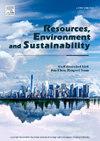European Union agro-climate policies toward sustainability: Analyzing emission trends and land use dynamics (1990–2021)
IF 12.4
Q1 ENVIRONMENTAL SCIENCES
引用次数: 0
Abstract
The agricultural sector plays a pivotal role in the carbon cycle, making the evaluation of the food–climate nexus essential for effective mitigation policy. This study assesses greenhouse gas (GHG) emission dynamics across the European Union (EU-27) from 1990 to 2021. While 20 of the 27 countries showed significant reductions in emissions (p < 0.05), Mann–Kendall trend analysis revealed an overall significant decline (p < 0.0001), with a Sen’s slope of −2,190 kt CO2 eq/year. Land use data from CORINE indicated a modest 0.08% expansion in agricultural land, primarily non-irrigated arable land, resulting in a net gain of 2.27 million hectares. Autoregressive distributed lag modeling revealed a short-run reduction (−0.07%) but a long-run increase (+0.15%) in GHG emissions linked to agricultural land expansion. Granger causality analysis identified strong unidirectional relationships from agricultural drivers—including land use, value-added agriculture, crop and livestock production, and fertilizer use—to emissions. Notably, forest area increased by 12%, contributing to significant emission reductions, and showed bidirectional causality with agricultural land. These results exposed a persistent gap between emission trends and policy targets, recommending for countries and sector-specific interventions in agriculture, livestock, and land-use governance.

面向可持续发展的欧盟农业气候政策:排放趋势和土地利用动态分析(1990-2021)
农业部门在碳循环中发挥着关键作用,因此评估粮食-气候关系对于制定有效的减缓政策至关重要。本研究评估了1990年至2021年整个欧盟(EU-27)的温室气体排放动态。虽然27个国家中有20个国家的排放量大幅减少(p <;0.05), Mann-Kendall趋势分析显示整体显著下降(p <;0.0001), sens斜率为- 2190 kt CO2当量/年。CORINE的土地利用数据显示,农业用地(主要是非灌溉耕地)适度增长了0.08%,净增长227万公顷。自回归分布滞后模型显示,与农业用地扩张相关的温室气体排放短期减少(- 0.07%),但长期增加(+0.15%)。格兰杰因果分析发现,农业驱动因素(包括土地利用、增值农业、作物和牲畜生产以及化肥使用)与排放之间存在很强的单向关系。森林面积增加了12%,对减排贡献显著,且与农用地呈双向因果关系。这些结果揭示了排放趋势与政策目标之间的持续差距,并建议各国和部门在农业、畜牧业和土地利用治理方面采取具体干预措施。
本文章由计算机程序翻译,如有差异,请以英文原文为准。
求助全文
约1分钟内获得全文
求助全文
来源期刊

Resources Environment and Sustainability
Environmental Science-Environmental Science (miscellaneous)
CiteScore
15.10
自引率
0.00%
发文量
41
审稿时长
33 days
 求助内容:
求助内容: 应助结果提醒方式:
应助结果提醒方式:


